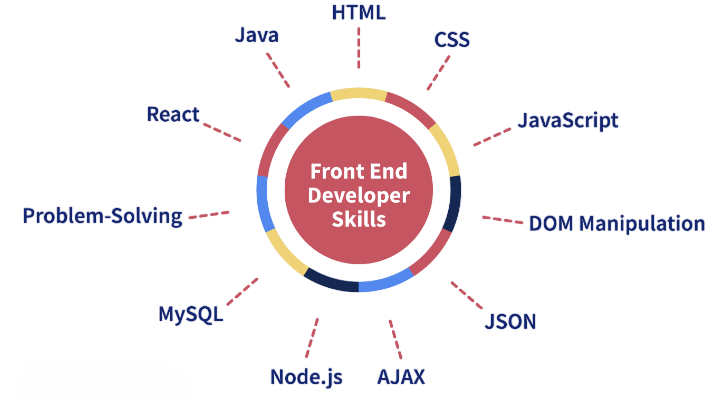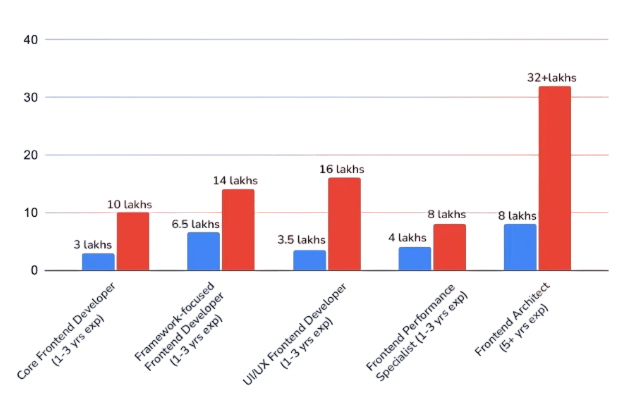
- Who is a Front-End Developer?
- Skills and Tools Required
- Entry-Level Salary
- Experienced Developer Salary
- Location-Based Salary Comparison
- Salary by Company
- Freelancing vs Full-Time Roles
- Career Progression and Raises
Who is a Front-End Developer?
A Front-End Developer is a specialized software engineer focused on building the visual and interactive elements of web applications that users engage with directly through their browsers. They transform design wireframes and mockups into functional, attractive, and responsive interfaces using core web technologies such as HTML, CSS, and JavaScript. Their work ensures that websites and applications not only look appealing but also deliver seamless user experiences. Front-End Developers collaborate closely with designers, back-end developers, and product managers to bridge the gap between design concepts and technical implementation. This collaboration helps ensure that the final product aligns with user needs and business goals, a key focus of Web Designing Training. They are responsible for optimizing website performance by minimizing load times and improving responsiveness, which enhances overall user satisfaction. A critical part of their role is ensuring cross-browser compatibility, making sure that web applications perform consistently across various browsers and devices. Additionally, they implement accessibility standards to make digital content usable for people with diverse abilities, broadening the reach of web applications. Front-End Developers also maintain clean, modular, and reusable code to streamline ongoing maintenance and future enhancements. As companies across industries increasingly adopt digital solutions, the demand for skilled front-end developers continues to grow. Their expertise plays a vital role in driving digital transformation by creating engaging, efficient, and inclusive web experiences that meet the evolving expectations of users worldwide.
Interested in Obtaining Your Web Developer Certificate? View The Web Developer Courses Offered By ACTE Right Now!
Skills and Tools Required
Front-End Developers need a diverse set of skills and tools to effectively create engaging and efficient web interfaces. At the core, proficiency in HTML, CSS, and JavaScript is essential. HTML structures the content on the web page, CSS styles and visually arranges that content, while JavaScript adds interactivity and dynamic behavior. Beyond these basics, knowledge of modern JavaScript frameworks and libraries such as React, Angular, or Vue.js is highly valuable, as these tools streamline development and improve code maintainability. Understanding responsive design principles is critical to ensure that websites look and function well on a variety of devices, from desktops to smartphones, which directly impacts Front End Developer Salary in India. This often involves mastering CSS preprocessors like Sass or Less and frameworks like Bootstrap or Tailwind CSS, which facilitate rapid, consistent styling. Front-End Developers also use version control systems such as Git to manage and track changes in their code collaboratively. To optimize performance and accessibility, developers utilize debugging and testing tools such as Chrome DevTools and automated testing frameworks like Jest or Cypress. Familiarity with build tools and package managers like Webpack, Babel, npm, or Yarn helps in bundling and managing dependencies efficiently. Soft skills such as problem-solving, attention to detail, and effective communication are equally important because front-end development is highly collaborative and iterative.

Additionally, staying current with evolving web standards, browser behaviors, and emerging technologies is necessary to create cutting-edge digital experiences. By mastering this blend of technical expertise and collaborative tools, Front-End Developers deliver seamless, user-friendly web applications that meet modern digital demands.
Entry-Level Salary
- Entry-Level Salary in India: An entry-level front-end developer in India with 0 to 2 years of experience typically earns between INR 3 to 6 lakhs per annum. The range varies depending on the city, company size, and individual skills. Tech hubs like Bengaluru and Hyderabad usually offer higher salaries due to demand.
- United States Salary Range: In the United States, entry-level front-end developers can expect annual salaries between USD 55,000 and 75,000. The higher end is often seen in tech-centric cities such as San Francisco, Seattle, and New York, where the cost of living and demand for skilled developers is high.
- United Kingdom Salary Range: Entry-level front-end developers in the UK typically earn between GBP 25,000 and 40,000 per year. London-based roles usually offer salaries at the upper end of this range due to its status as a financial and tech hub.
- Canada Salary Expectations: In Canada, beginners in front-end development can expect CAD 45,000 to 65,000 annually, with foundational knowledge such as Control Statements in Java often enhancing their skills.
- Germany Salary Overview: Germany offers entry-level front-end developers between EUR 40,000 and 55,000 per year. Berlin and Munich are notable cities where technology companies are growing rapidly, influencing higher compensation.
- Australia Salary Range: In Australia, entry-level developers earn approximately AUD 60,000 to 80,000 yearly. Sydney and Melbourne are the primary tech hubs offering competitive salaries and numerous job opportunities.
- Factors Influencing Compensation: Candidates with personal projects, active GitHub contributions, internships, or bootcamp training often secure better compensation. Additionally, certifications from recognized programs such as Google, freeCodeCamp, or Meta enhance a candidate’s credibility and can significantly impact salary offers.
- India Salary for Experienced Developers: Front-end developers with 3 to 7 years of experience in India typically earn between INR 8 to 18 lakhs per annum. Salaries vary by city, with tech hubs like Bengaluru, Mumbai, and Delhi offering the highest compensation.
- United States Salary Range: In the US, experienced front-end developers earn roughly USD 90,000 to 140,000 annually. Salaries can be higher for those with expertise in popular frameworks such as React or Angular, especially in tech centers like Silicon Valley and New York.
- United Kingdom Compensation: Experienced developers in the UK generally receive between GBP 50,000 and 75,000 yearly, with skills gained from Web Designing Training often enhancing their prospects. London-based roles and those with advanced front-end skills tend to be on the higher end of the pay scale.
- Canada Salary Expectations: In Canada, seasoned front-end developers earn around CAD 75,000 to 110,000 annually. Cities like Toronto and Vancouver, with booming tech industries, typically offer competitive salaries.
- Germany Salary Overview: Experienced front-end developers in Germany make between EUR 55,000 and 80,000 per year. Berlin and Munich, known for vibrant tech scenes, usually offer salaries toward the top of this range.
- Australia Salary Range: In Australia, developers with experience earn approximately AUD 90,000 to 120,000 annually. Sydney and Melbourne remain the main hubs offering these competitive salaries.
- Factors Affecting Salary: Salaries tend to increase for developers with leadership experience, proficiency in advanced frameworks, or those contributing to large-scale projects. Certifications, ongoing learning, and open-source contributions also boost earning potential.
- India – Large IT Firms: In India, entry-level front-end developers at established IT service companies like TCS, Infosys, and Wipro typically earn between INR 3 to 6 lakhs per annum. Senior developers at these firms can expect salaries ranging from INR 8 to 14 lakhs annually, reflecting their experience and responsibilities.
- India – Startups: Indian startups such as Razorpay and Zomato generally offer higher salaries compared to traditional IT firms. Entry and mid-level developers can earn between INR 7 to 20 lakhs per year, depending on the startup’s stage and funding. These companies often provide dynamic work environments and faster career growth opportunities.
- India – Product Giants: Global product companies like Google and Amazon offer significantly higher compensation in India, with experienced front-end developers earning between INR 25 to 50 lakhs annually, especially those skilled in Exploring the Various Decorators in Angular. These firms provide competitive pay, comprehensive benefits, and exposure to cutting-edge technologies.
- United States – FAANG Companies: In the US, front-end developers working at FAANG companies Meta, Amazon, Apple, Netflix, and Google can expect salaries ranging from USD 140,000 to 200,000 annually. These roles often come with stock options and other incentives, boosting total compensation.
- United States – Mid-Size Firms and Startups: Mid-size tech firms in the US typically offer salaries between USD 90,000 and 130,000. Startups provide slightly lower base pay, usually USD 70,000 to 110,000, but often include equity as part of the compensation package.
- UK & Europe – Established Companies: In the UK and Europe, companies such as SAP, Siemens, and Booking.com pay front-end developers salaries ranging from GBP 50,000 to 80,000, reflecting a mature job market with competitive benefits.
- Australia & Canada – Leading Tech Companies: Top tech companies like Atlassian in Australia and Shopify in Canada offer attractive salaries to experienced front-end developers, with annual pay often exceeding AUD 100,000 and CAD 95,000, respectively.
To Explore Web Developer in Depth, Check Out Our Comprehensive Web Developer Courses To Gain Insights From Our Experts!
Experienced Developer Salary

Location-Based Salary Comparison
Salaries for Front-End Developers vary significantly depending on geographic location, reflecting differences in cost of living, demand for tech talent, and the maturity of the local tech industry. In major tech hubs like San Francisco, New York, and Seattle, front-end developers tend to command higher salaries due to the high concentration of technology companies and competitive job markets. For instance, in Silicon Valley, a skilled Front-End Developer can earn a six-figure salary, often supplemented by bonuses and stock options. However, these higher wages are usually offset by the elevated cost of living in these metropolitan areas. In contrast, salaries in smaller cities or regions with less developed tech ecosystems may be lower but can still provide a comfortable standard of living, even for those working with the Top 10 Python Libraries for Machine Learning. Cities such as Austin, Denver, or Raleigh offer growing tech scenes with competitive salaries that are often more balanced with local living expenses. Furthermore, remote work has blurred traditional location boundaries, allowing developers to work for companies in higher-paying regions while living in more affordable areas, thereby potentially increasing their net income. Internationally, salary disparities are even more pronounced. Front-End Developers in countries with established technology sectors, like Germany, the UK, or Canada, generally earn higher wages compared to those in emerging markets. However, global differences in taxation, benefits, and quality of life also factor into the overall compensation package. Ultimately, when considering salary, Front-End Developers should weigh location-based earning potential alongside cost of living, job market conditions, and career growth opportunities to make informed decisions about where to work.
Do You Want to Learn More About Web Developer? Get Info From Our Web Developer Courses Today!
Salary by Company
Freelancing vs Full-Time Roles
Front-End Developers often face the choice between freelancing and full-time employment, each offering distinct advantages and challenges. Full-time roles typically provide stability, a steady paycheck, and benefits such as health insurance, paid leave, and retirement plans. Working within a company environment also offers opportunities for collaboration, mentorship, and career progression through promotions and skill development programs. Full-time developers often have access to structured workflows, dedicated teams, and resources that support large-scale projects and long-term product development. On the other hand, freelancing provides greater flexibility and autonomy. Freelance Front-End Developers can choose their projects, set their schedules, and often work remotely from any location, applying their skills in Practical Applications of Python. This freedom allows for a better work-life balance and the chance to diversify one’s portfolio by working with different clients across various industries. However, freelancing also involves uncertainties such as irregular income, the need for self-marketing, and managing business aspects like contracts, invoicing, and taxes. Freelancers must continually find new clients and stay disciplined to maintain steady workflows. Financially, full-time roles usually offer consistent income and benefits but may come with fixed salaries that limit earning potential. Freelancers can potentially earn more by taking on multiple projects or charging premium rates for specialized skills but must handle gaps between contracts. Both paths require strong technical skills, communication abilities, and time management, but the choice depends largely on individual preferences for security versus independence. Many developers also combine both, taking freelance projects alongside full-time jobs to maximize income and experience.
Career Progression and Raises
Career progression for Front-End Developers typically follows a structured path, starting from junior roles to more senior positions with increasing responsibilities. Entry-level developers focus on learning core technologies like HTML, CSS, and JavaScript while gaining experience in implementing designs and fixing bugs. As they advance, developers take on more complex tasks such as optimizing performance, improving user experience, and contributing to architecture decisions. Mid-level and senior developers often mentor juniors, lead projects, and collaborate more closely with cross-functional teams, including designers and back-end engineers. Beyond senior developer roles, opportunities include positions like Lead Front-End Developer, UI/UX Specialist, or Front-End Architect, where individuals shape the overall design and technical direction of projects, skills often developed through Web Designing Training. Some Front-End Developers also transition into full-stack roles by expanding their skills to back-end development or move into management and product roles. Continuous learning, staying updated with new frameworks and tools, and building a strong portfolio are key to career growth. Raises and salary increases generally correlate with experience, skill set, and impact on the company’s projects. Promotions to higher-level roles often come with significant pay bumps, reflecting greater expertise and leadership. Additionally, developers who specialize in high-demand areas such as performance optimization, accessibility, or advanced JavaScript frameworks may command higher salaries. Regular performance reviews and clear goal-setting help ensure raises are aligned with individual contributions. In fast-growing tech companies, exceptional developers may also receive bonuses, stock options, or other incentives. Ultimately, proactive skill development, effective communication, and delivering measurable results play crucial roles in advancing a Front-End Developer’s career and increasing their earning potential.



